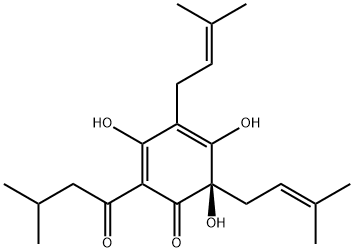(R)-Humulone (CAS# 26471-41-3) can be used as a chemosensory receptor ligand.
ChEBI: Humulone is an optically active cyclic ketone consisting of 3,5,6-trihydroxycyclohexa-2,4-dien-1-one bearing two 3-methylbut-2-en-1-yl substituents at positions 4 and 6 as well as a 3-methylbutanoyl group at the 2-position. It has a role as an antibacterial drug, an antioxidant, a cyclooxygenase 2 inhibitor and a metabolite. It is a diketone, a triol, a cyclic ketone, an aromatic ketone and a tertiary alpha-hydroxy ketone.
Humulone (10 or 20 mg/kg; IP; single dose) shortens sleep onset and increases the duration of sleep induced by pentobarbital and decreases the spontaneous locomotion in open field at 20 mg/kg[2].
Humulone (10 μmol; applied topically to the dorsal shaved area) pre-treatment significantly inhibited TPA (10 nmol)-induced COX-2 expression in Female ICR mice (6-7 weeks of age) skin[3].
Humulone (1, 10 μmol; applied topical; pre-treatment 30 min) suppresses TPA-induced NF-κB DNA binding. Humulone attenuates TPA-stimulated nuclear translocation of p65 and p50 subunit proteins of NF-κB[3].
| Animal Model: | Male BALB/cAnNRj mice (9-11 weeks of age)[2] |
| Dosage: | 10 or 20 mg/kg |
| Administration: | IP; pre-treatment before sodium pentobarbital (35 mg/kg; i.p.) and ethanol (3.5 g/kg) |
| Result: | Significantly decreased the latency and prolonged the duration of sleep induced by pentobarbital at 20 mg/kg dose. These effects were not observed at a lower dose of 10 mg/kg.
Showed no effect on the onset of sleep induced by ethanol, but significantly increased sleep duration dose-dependently.
|
IL Receptor | AP-1 | COX | p65 | NF-kB | IkB | VEGFR | Antifection | IKK
Crystallise humulon from Et2O. It dissolves slightly in hot H2O but precipitates on cooling. It has max () 237 (13,760) and 282 (8,330) in EtOH. [Wollmer Chem Ber 49 780 1916, Carson J Am Chem Soc 73 4652 1951, Beilstein 8 II 537, 8 III 4034, 8 IV 3410.]
